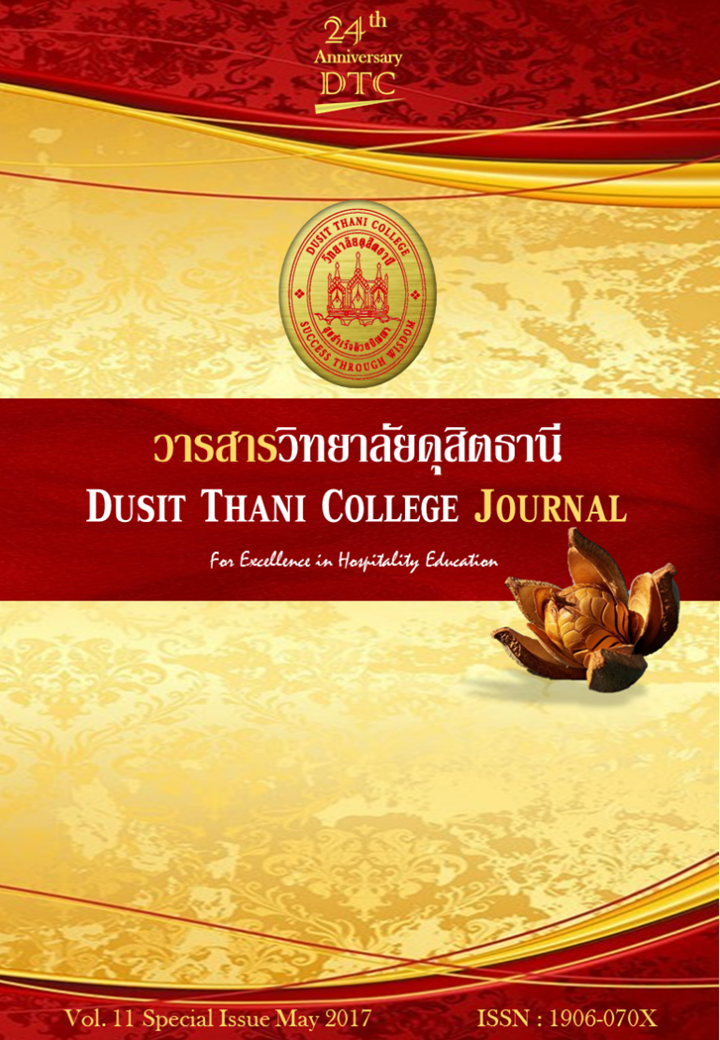การยกระดับขีดความสามารถทางการแข่งขันและกลไกการจัดการตลาดการท่องเที่ยวโดยชุมชนแหล่งมรดกทางวัฒนธรรมลุ่มน้ำโขง ชี มูล ในภาคตะวันออกเฉียงเหนือของประเทศไทย
Main Article Content
บทคัดย่อ
การวิจัยนี้มีวัตถุประสงค์เพื่อ 1. พัฒนาให้เกิดเครือข่ายวิสาหกิจท่องเที่ยวโดยชุมชนและพัฒนาศักยภาพและความสามารถของทรัพยากรมนุษย์ของแหล่งมรดกทางวัฒนธรรมลุ่มน้ำโขง ชี มูล ในภาคตะวันออกเฉียงเหนือของประเทศไทย 2. พัฒนาแผนและกลไกการจัดการเครือข่ายทางการตลาดแหล่งมรดกทางวัฒนธรรมลุ่มน้ำโขง ชี มูล ในภาคตะวันออกเฉียงเหนือของประเทศไทย 3. พัฒนาแผนการตลาด (Marketing Plan) เครือข่ายการท่องเที่ยวโดยชุมชนแหล่งมรดกทางวัฒนธรรมลุ่มน้ำโขง ชี มูล ในภาคตะวันออกเฉียงเหนือของประเทศไทย 4. ยกระดับขีดความสามารถทางการแข่งขันและกลไกการจัดการตลาดโดยอาศัยกระบวนการมีส่วนร่วมของชุมชนท่องเที่ยวในแหล่งมรดกทางวัฒนธรรมลุ่มน้ำโขง ชี มูล ในภาคตะวันออกเฉียงเหนือของประเทศไทย โดยใช้อาศัยกระบวนการวิจัยแบบชุมชนมีส่วนร่วมอย่างแท้จริง และมีเครื่องมือในการวิจัย ได้แก่ แบบสอบถาม แบบประเมินขีดความสามารถทางการแข่งขันทางการท่องเที่ยว แบบสัมภาษณ์และแบบสนทนากลุ่มในประเด็นการพัฒนาทรัพยากรมนุษย์ โดยเก็บข้อมูลกับกลุ่มตัวอย่าง คือ สมาชิกของชุมชนท่องเที่ยวในแหล่งมรดกทางวัฒนธรรมลุ่มน้ำโขง ชี มูล ในภาคตะวันออกเฉียงเหนือของประเทศไทย
ผลการวิจัยพบว่า ชุมชนที่จัดการการท่องเที่ยวในแหล่งมรดกทางวัฒนธรรมลุ่มน้ำโขง ชี มูล ในภาคตะวันออก เฉียงเหนือมีศักยภาพด้านการตลาดในระดับปานกลาง และจากกระบวนการวิจัยทำให้เกิดเครือข่ายการตลาดการท่องเที่ยว จำนวน 1 เครือข่าย โดยมีกลไกสำคัญ 3 ส่วน คือ กลไกด้านคน คือ เครือข่าย กลไกด้านการจัดการ คือ แผนการจัดการเครือข่ายและแผนการตลาดของเครือข่าย และกลไกด้านงบประมาณ นอกจากนี้ ในการสร้างความเข้มแข็งและยั่งยืนให้กับเครือข่าย จำเป็นการพัฒนาองค์ความรู้ให้กับทรัพยากรมนุษย์ที่อยู่ในเครือข่ายการท่องเที่ยวให้มีศักยภาพและความสามารถในการจัดการตลาดการท่องเที่ยว โดยมีมิติการพัฒนา 3 ด้านได้แก่ มิติด้านความรู้ คือ การให้ความรู้เกี่ยวกับเครือข่าย การจัดทำแผนของเครือข่าย แผนการตลาด และการจัดการตลาดการท่องเที่ยวโดยชุมชนอย่างยั่งยืน มิติด้านการพัฒนาแนวคิดและวิธีคิด โดยอาศัยการสอดแทรกในกระบวนการของการพัฒนาแผนและกลไก การศึกษาดูงาน การแลกเปลี่ยนกับเครือข่ายโดยชุมชนในแหล่งมรดกทางวัฒนธรรมลุ่มน้ำโขง ชี มูล ในภาคตะวันออกเฉียงเหนือของประเทศไทยด้วยกัน และเครือข่ายจากภายนอก และมิติการมีส่วนร่วม คือ การสร้างกระบวนการมีส่วนร่วมในการร่วมคิด ร่วมวางแผน และร่วมปฏิบัติการให้เกิดประสบการณ์จริง
ข้อเสนอแนะสำหรับการพัฒนาการจัดการตลาดท่องเที่ยวโดยชุมชนในแหล่งมรดกทางวัฒนธรรมลุ่มน้ำโขง ชี มูล ในภาคตะวันออกเฉียงเหนือ ควรให้ความสำคัญกับการดำเนินงาน 3 มิติ คือ มิติของยกระดับขีดความ สามารถทางการแข่งขัน มิติของการพัฒนาเครือข่ายการท่องเที่ยว และมิติด้านการจัดการตลาดการท่องเที่ยวโดยชุมชนแหล่งมรดกทางวัฒนธรรมลุ่มน้ำโขง ชี มูล ในภาคตะวันออกเฉียงเหนือของประเทศไทยควรมีการพัฒนาความรู้ความเข้าใจ และกระบวนการในการวางแผนและดำเนินงานด้านการตลาดแบบเป็นกระบวนการและอาศัยเครือข่ายเป็นตัวเชื่อมการดำเนินงาน เน้นการสร้างศักยภาพการตลาดด้านผลิตภัณฑ์ การบริการ และด้านการส่งเสริมการขายให้มาก ควรจัดหาพี่เลี้ยงหรือหน่วยงานการให้คำปรึกษาและช่วยเหลือด้านการตลาดกับชุมชน เร่งสร้างบุคลากรในชุมชนที่จะเป็นตัวแทนของเครือข่ายการท่องเที่ยว (Cluster Agent) หรือผู้ที่มีความรู้ความเข้าใจด้านการตลาดอย่างแท้จริงให้เกิดขึ้นในชุมชน
Article Details
นโยบายการพิจารณากลั่นกรองบทความ
- บทความวิจัยและบทความวิชาการทุกเรื่องที่จะได้รับการตีพิมพ์ต้องผ่านการพิจารณากลั่นกรองโดยผู้ทรงคุณวุฒิ (Peer Review) ในสาขาที่เกี่ยวข้อง จำนวน 3 ท่าน/บทความ
- บทความ ข้อความ ภาพประกอบและตารางประกอบที่ลงตีพิมพ์ในวารสารเป็นความคิดเห็นส่วนตัวของผู้เขียน กองบรรณาธิการไม่จำเป็นต้องเห็นด้วยเสมอไป และไม่มีส่วนรับผิดชอบใด ๆ ถือเป็นความรับผิดชอบของผู้เขียนแต่เพียงผู้เดียว
- บทความที่จะได้รับการตีพิมพ์จะต้องไม่เคยตีพิมพ์ เผยแพร่ที่ใดมาก่อน และไม่อยู่ระหว่างการพิจารณาของวารสารฉบับอื่น หากตรวจสอบพบว่ามีการตีพิมพ์ซ้ำซ้อน ถือเป็นความรับผิดชอบของผู้เขียนแต่เพียงผู้เดียว
- บทความใดที่ผู้อ่านเห็นว่าได้มีการลอกเลียนหรือแอบอ้างโดยปราศจากการอ้างอิง หรือทำให้เข้าใจผิดว่าเป็นผลงานของผู้เขียน กรุณาแจ้งให้กองบรรณาธิการวารสารทราบจะเป็นพระคุณยิ่ง
เอกสารอ้างอิง
Chinnak, Sommai. (2549). The Study of Tourist Destinations in Southern Laos in Order to Link with The lower Northeastern Part of Thailand’s Tourist Destination. Thailand Research Found. Bangkok.
Clarke and Clegg.(1998). Changing Paradigms: The Transformation of Management Knowledge for the 21st Century. HarperCollins Business (London).
Community Based Tourism Institute, (2557). ชุมชนท่องเที่ยว. (ระบบออนไลน์). แหล่งที่มา https://www.cbt-i.org/?&start=0&page=1&ge=travel&categoryTravel=®ionTravel
=&provinceTravel=&keyword=&search=search.(17 กรกฎาคม 2557).
G.Richard and B. Richard, (1991). International Themes, Leisure Management, October,46-48.
Goeldner, Ritchie and Mcintosh. 1998. Tourism: Principle and Philosophies. John Wiley & Sons Australia (Brisbane). England.
Khongthon, Netchanok. (2555). Creation of Communication of Cultural Tourism Image Based on River Basin Civilization at Korat Plateau in Perception of Tourist. National Research Council of Thailand . Bangkok.
McIntosh, Robert and Goeldner, Charles R, (1998). Tourism Principles, Practices, Philosophies, 5th.ed. New York: John Wiley and Sons, Inc.
Netirangsriwatchara, Apiradee. (2555). The Study of Cultural Creation Model Based on River Basin of Korat Plato to Manage Cultural Tourism Activities. National Research Council of Thailand . Bangkok.
Swarbooke.(1998). Sustainable Tourism Management. CABI Pub. (New York).
Thothong, Kamkearng. (2551). Tourism Route of Khmer Civilization in The Lower Northeastern Parts of Thailand, Cambodia and Laos. Thailand Research Found. Bangkok.
Thongdee, Nattinee. (2550). The Strategic of Homestay Tourism Promotion for Youth Tourist in Northeastern Region, Thailand. Thailand Research Found. Bangkok.
Thongdee, Nattinee. (2555). Knowledge Management on Tourism Interpretation in Cultural Tourism Destination at River Basin Civilization, Korat Plateau. National Research Council of Thailand . Bangkok.
Thongdee, Nattinee. (2555). Cultural Tourism Management Based on River Basin Civilization at Korat Plato’s life style for Tourism Value Added and Local Cultural Identity Conservation. National Research Council of Thailand . Bangkok.


